An Investigation into the Wear Behavior of Martensitically Transformed Nitrided Layers
Abstract
:1. Introduction
2. Materials and Methods
2.1. Investigation Materials
2.2. Surface Heat Treatment
2.2.1. Nitriding
2.2.2. Induction Heat Treatment
2.2.3. Experimental Design
2.3. Wear Testing
2.3.1. Two-Disc Test Rig
2.3.2. Determination of the Wear Coefficients
- with VV→wear volume in mm3
- r→radius of the wear track in mm
- AV→wear area in mm2
- KS→wear coefficient of the specimen in mm3/Nm
- FN→normal force in N
- L→sliding distance in m
3. Results
3.1. Surface Roughness
3.2. Microhardness
3.3. Weight Loss
3.4. Wear Coefficients
4. Discussion
4.1. Wear Behavior of the Nitrided Only Condition
4.2. Wear Behavior of the Nitrided and Induction Hardened Condition
5. Summary
6. Conclusions
- Variants without compound layers initially showed better wear resistance due to lower surface roughness.
- PN1 with a 3 µm compound layer excelled initially, while PN2 wore out its layer quickly.
- All nitrided variants had similar wear behavior when the compound layer was worn off.
- All variants showed increased initial wear due to the absence of the compound layer.
- Variants induction-hardened with a compound layer mostly had higher wear due to retained austenite and the resulting lower hardness, except for PN2.
- Removing the compound layer prior to induction hardening reduced retained austenite and in consequence wear.
- Surface hardness correlated with retained austenite content.
Author Contributions
Funding
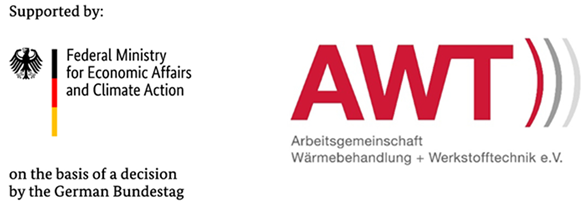
Data Availability Statement
Acknowledgments
Conflicts of Interest
References
- Boniardi, M.; D’Errico, F.; Tagliabue, C. Influence of carburizing and nitriding on failure of gears—A case study. Eng. Fail. Anal. 2006, 13, 312–339. [Google Scholar] [CrossRef]
- Steinbacher, M.; Surm, H.; Clausen, B.; Lübben, T.; Hoffmann, F. Systematische Untersuchung verschiedener Einflussgrößen auf die Maß- und Formänderungen von einsatzgehärteten Stirnrädern. HTM J. Heat Treat. Mater. 2012, 67, 65–78. [Google Scholar] [CrossRef]
- Steinbacher, M.; Hoffmann, F.; Zoch, H.-W.; Lombardo, S.; Tobie, T. Neue Randschichtgefüge carbonitrierter Bauteile und deren Festigkeitseigenschaften: Teil 1: Untersuchungen werkstofftechnischer Eigenschaften. HTM J. Heat Treat. Mater. 2015, 70, 201–217. [Google Scholar] [CrossRef]
- Koenig, J.; Tobie, T.; Stahl, K. Nitriding of Heavily Loaded Gears—Potentials and Challenges. In Proceedings of the ECHT—European Conference on Heat Treatment Nitriding and Nitrocarburising, Friedrichshafen, Germany, 12–13 April 2018; pp. 45–50. [Google Scholar]
- Nöbauer, R.; Mozden, G.; Dallhammer, G.; Jansson, M. Nitriding of lightweight gears for space applications—A real challenge. In Proceedings of the ECHT—European Conference on Heat Treatment Nitriding and Nitrocarburising, Friedrichshafen, Germany, 12–13 April 2018; pp. 51–56. [Google Scholar]
- Sitzmann, A.; Tobie, T.; Stahl, K.; Schurer, S. Influence of the Case Properties After Nitriding on the Load Carrying Capacity of Highly Loaded Gears. In Proceedings of the ASME International Design Engineering Technical Conferences and Computers and Information in Engineering Conference, Anaheim, CA, USA, 18–21 August 2019. [Google Scholar]
- Hoja, S.; Geitner, M.; Zornek, B.; Hoffmann, F.; Tobie, T.; Stahl, K.; Fechte-Heinen, R. Influence of the Nitrided Layer Structure on the Micro-Pitting and Wear Behavior of Slow-Running Nitrided External Gears. Lubricants 2022, 10, 88. [Google Scholar] [CrossRef]
- Dobler, F. Einflüsse auf die Tragfähigkeit Induktiv Umlaufgehärteter Stirnräder. Ph.D. Thesis, TU München, Munich, Germany, 2018. [Google Scholar]
- Jonck, R.; Kunze, G. Gefügeausbildung und Härte von Verbindungs- und Diffusionsschichten bad- und gasnitrierter Werkzeugstähle. Z. Wirtsch. Fabr. 1978, 73, 213–220. [Google Scholar]
- Jonck, R.; Kunze, G. Gefügeausbildung und Härte von Verbindungs- und Diffusionsschichten bad- und gasnitrierter Baustähle. Z. Wirtsch. Fabr. 1979, 74, 445–454. [Google Scholar] [CrossRef]
- Hoffmann, R.; Mittemeijer, E.J.; Somers, M.A.J. Verbindungsschichtbildung beim Nitrieren und Nitrocarburieren: Deutung der Nitridbildung, der Diffusion, Porenbildung und Kohlenstoffanreicherung. HTM Härterei Tech. Mitt. 1996, 51, 162–169. [Google Scholar] [CrossRef]
- Hoffmann, F.; Bujak, I.; Mayr, P.; Löffelbein, B.; Gienau, M.; Habig, K.-H. Verschleißwiderstand nitrierter und nitrocarburierter Stähle. HTM Härterei Tech. Mitt. 1997, 52, 376–386. [Google Scholar] [CrossRef]
- Ebersbach, U.; Vogt, F.; Naumann, J.; Zimdars, H. Lochfraßbeständigkeit von oxidierten Verbindungsschichten in Abhängigkeit vom (N+C)-Gehalt der ε-Phase. HTM Härterei Tech. Mitt. 1999, 54, 241–248. [Google Scholar] [CrossRef]
- Hoja, S.; Hoffmann, F.; Steinbacher, M.; Zoch, H.-W. Investigation of the Tempering Effect during Nitriding. HTM J. Heat Treat. Mater. 2018, 73, 335–343. [Google Scholar] [CrossRef]
- Stiele, H.; Marquis, F. An overview of inductive gear hardening. In Proceedings of the International Symposium on Heating by Electromagnetic Sources, Padua, Italy, 19–22 June 2007; pp. 183–195. [Google Scholar]
- Vöhringer, O.; Macherauch, E. Struktur und mechanische Eigenschaften von Martensit. HTM Härterei Tech. Mitt. 1977, 32, 153–202. [Google Scholar] [CrossRef]
- Hoja, S.; Nadolski, D.; Steinbacher, M.; Fechte-Heinen, R. Optimized Nitriding for Subsequent Induction Heat Treatment. HTM J. Heat Treat. Mater. 2021, 76, 261–272. [Google Scholar] [CrossRef]
- Hoja, S.; Haupt, N.; Steinbacher, M.; Fechte-Heinen, R. Martensitic Induction Hardening of Nitrided Layers. HTM J. Heat Treat. Mater. 2022, 77, 393–408. [Google Scholar] [CrossRef]
- Kulka, M.; Panfil, D.; Michalski, J.; Wach, P. The effects of laser surface modification on the microstructure and properties of gas-nitrided 42CrMo4 steel. Opt. Laser Technol. 2016, 82, 203–219. [Google Scholar] [CrossRef]
- Panfil, D.; Kulka, M.; Wach, P.; Michalski, J.; Przestacki, D. Nanomechanical properties of iron nitrides produced on 42CrMo4 steel by controlled gas nitriding and laser heat treatment. J. Alloys Compd. 2017, 706, 63–75. [Google Scholar] [CrossRef]
- Panfil, D.; Kulka, M.; Wach, P.; Michalski, J. Microstructure and wear resistance of gas-nitrided 42CrMo4 steel after laser modification. J. Achiev. Mater. Manuf. Eng. 2017, 85, 12–20. [Google Scholar] [CrossRef]
- Panfil-Pryka, D.; Kulka, M.; Makuch, N.; Michalski, J.; Dziarski, P. The Effect of Temperature Distribution During Laser Heat Treatment of Gas-Nitrided 42CrMo4 Steel on the Microstructure and Mechanical Properties. Coatings 2020, 10, 824. [Google Scholar] [CrossRef]
- Bergmann, H.W.; Müller, D.; Amon, M.; Domes, J. Kombination des Laserstrahlhärtens mit einer Kurzzeitnitrierbehandlung. HTM Härterei Tech. Mitt. 1993, 48, 238–248. [Google Scholar] [CrossRef]
- Keidel, C. Nitrocarburieren Plus Induktives Randschichthärten. Ph.D. Thesis, TU Berlin, Berlin, Germany, 1995. [Google Scholar]
- Zenker, R. Kombinierte thermochemische/Hochgeschwindigkeitsbehandlung—Einige Grundlagen und Behandlungsergebnisse. Neue Hütte 1986, 31, 1–6. [Google Scholar]
- Zenker, R. Kombiniertes Nitrocarburieren/Widerstandshärten bzw.—Vergüten des Stahles 50CrV4. HTM Härterei Tech. Mitt. 1988, 43, 5–15. [Google Scholar]
- Spies, H.-J.; Berg, H.-J.; Zimdars, H. Fortschritte beim sensorkontrollierten Gasnitrieren. HTM J. Heat Treat. Mater. 2003, 58, 189–197. [Google Scholar]
- Epp, J. XRD Methods for Materials Characterization in Material Characterization Using Nondestructive Evaluation (NDE) Methods; Woodhead Publishing: Cambridge, UK, 2016; pp. 81–124. [Google Scholar]
- DIN EN ISO 25178-1:2016-12; Geometrical Product Specifications (GPS)—Surface Texture: Areal—Part 1: Indication of Surface Texture. ISO: Geneva, Switzerland, 2016.
- DIN EN 1071-13:2010-07; Advanced Technical Ceramics—Methods of Test for Ceramic Coatings—Part 13: Determination of Wear Rate by the Pin-on-Disk Method. Beuth Verlag: Berlin, Germany, 2010.
- Hoja, S.; Baustert, R.; Hasselbruch, H.; Steinbacher, M.; Fechte-Heinen, R. Investigation of combined surface treatments and coatings to increase the wear behavior of heat treatable steels. Surf. Coat. Technol. 2023, 472, 129929. [Google Scholar] [CrossRef]
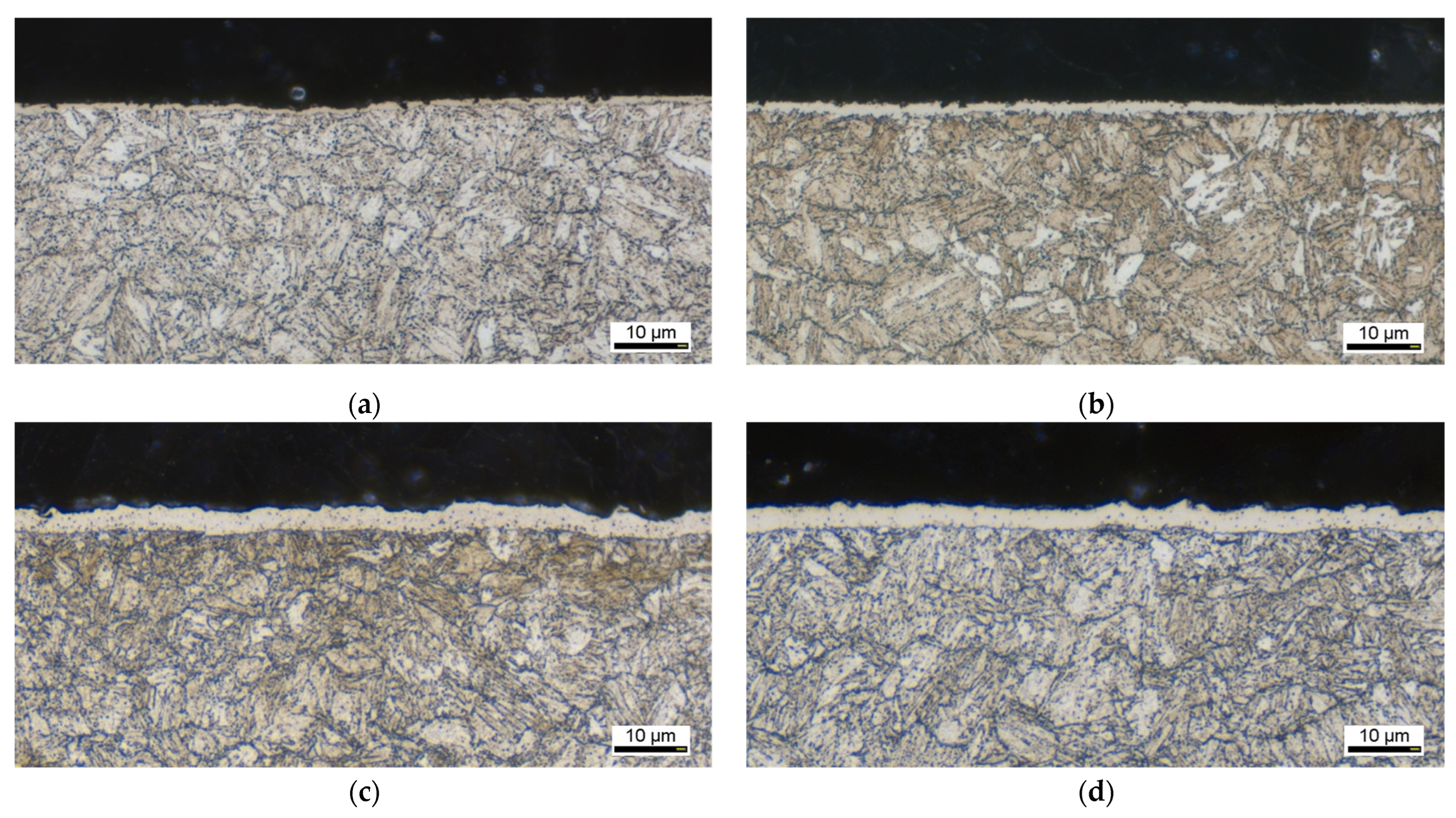

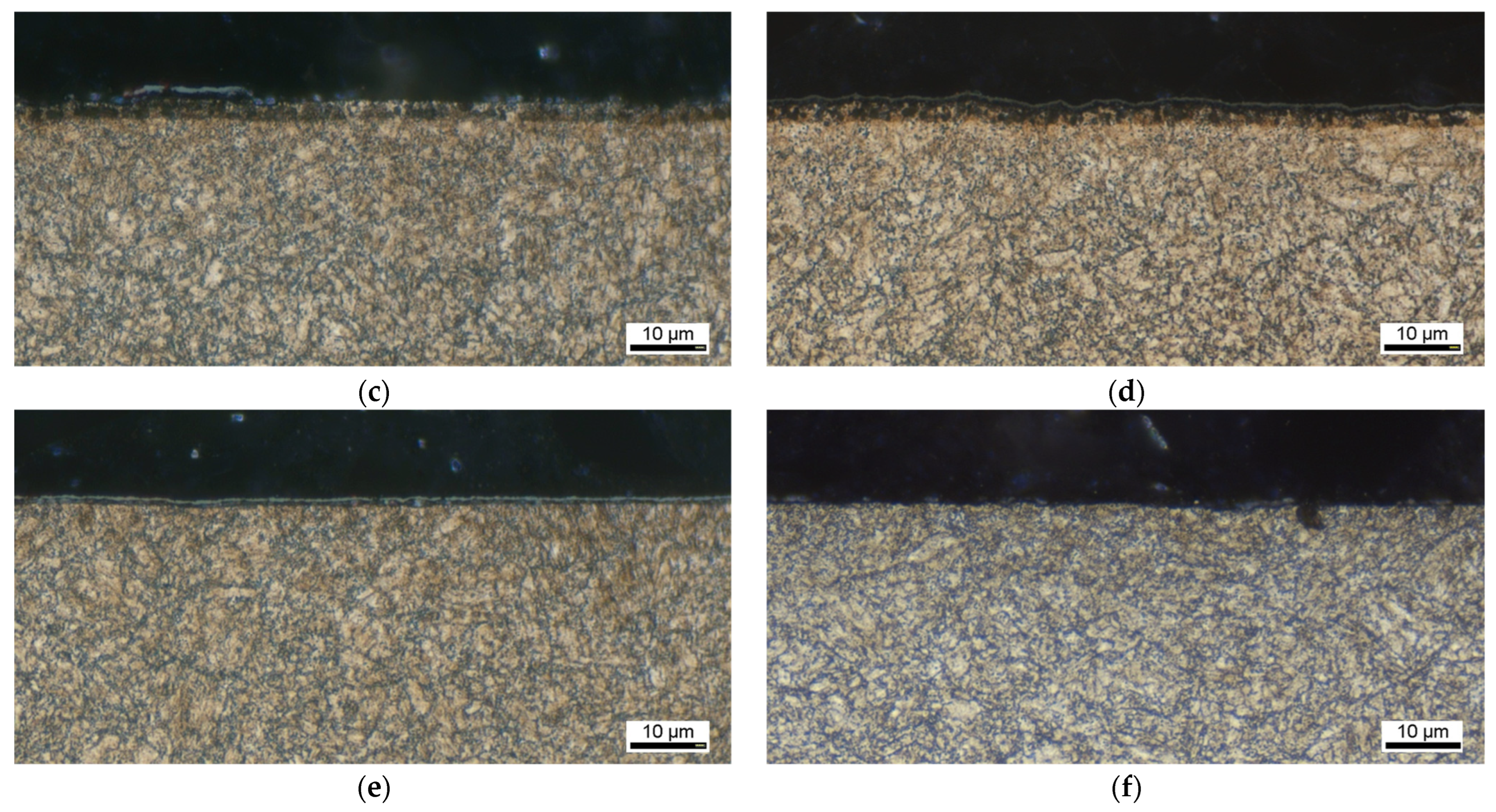

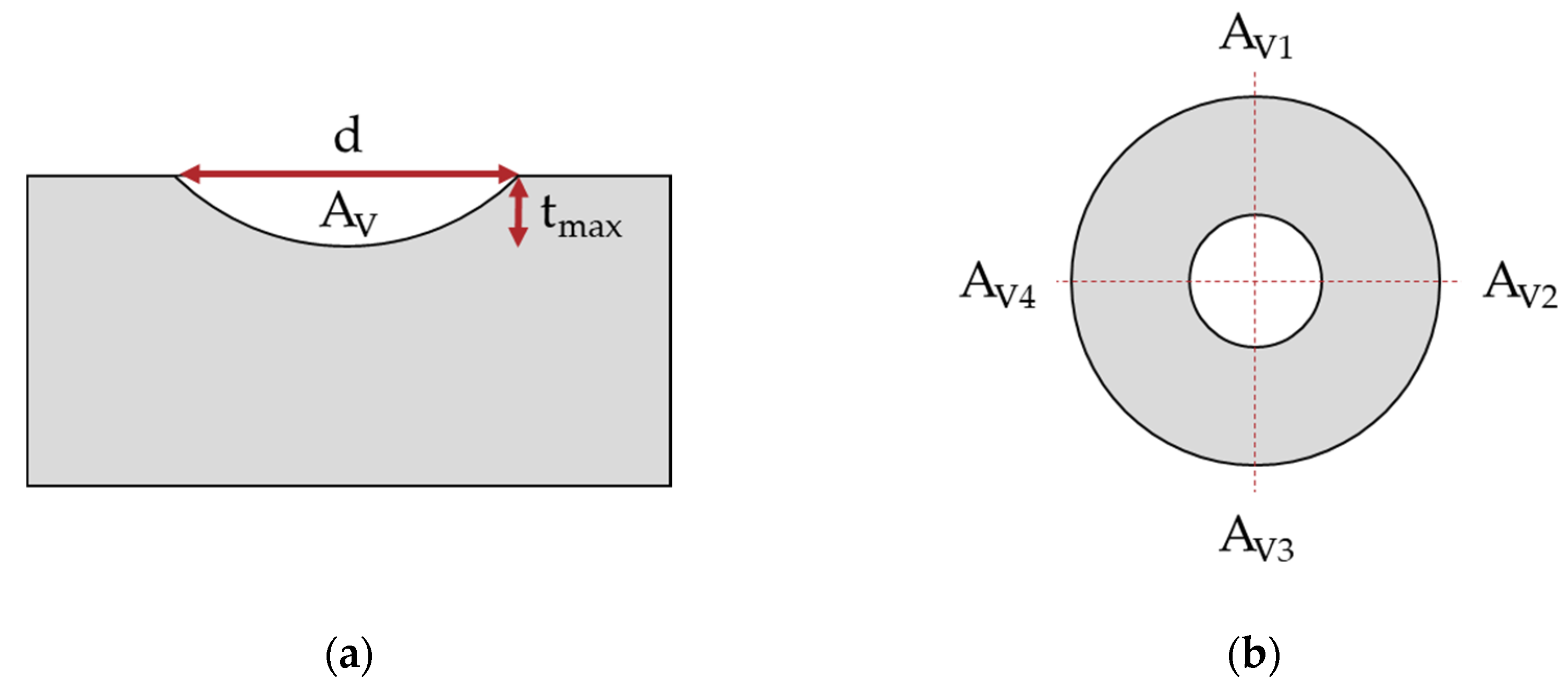
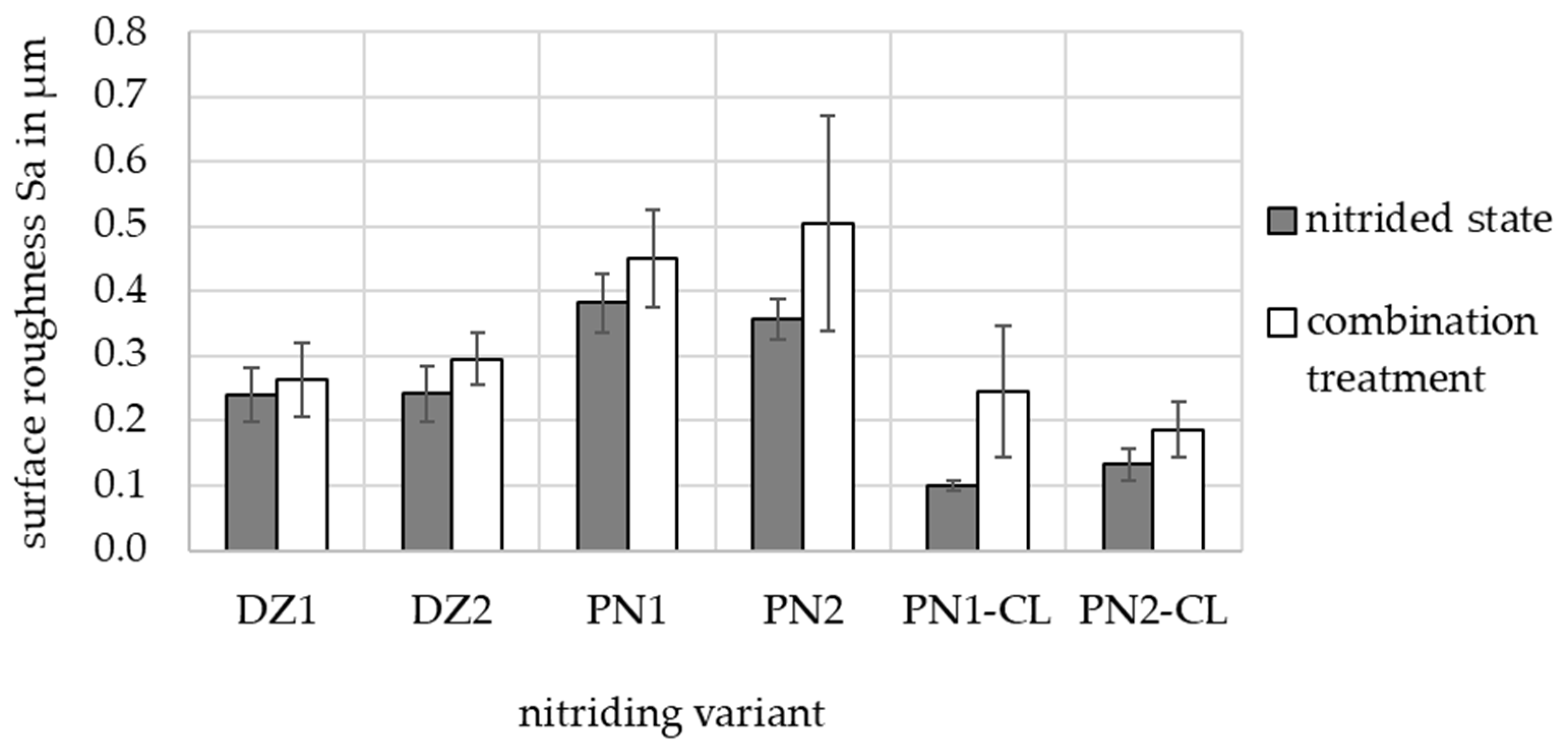

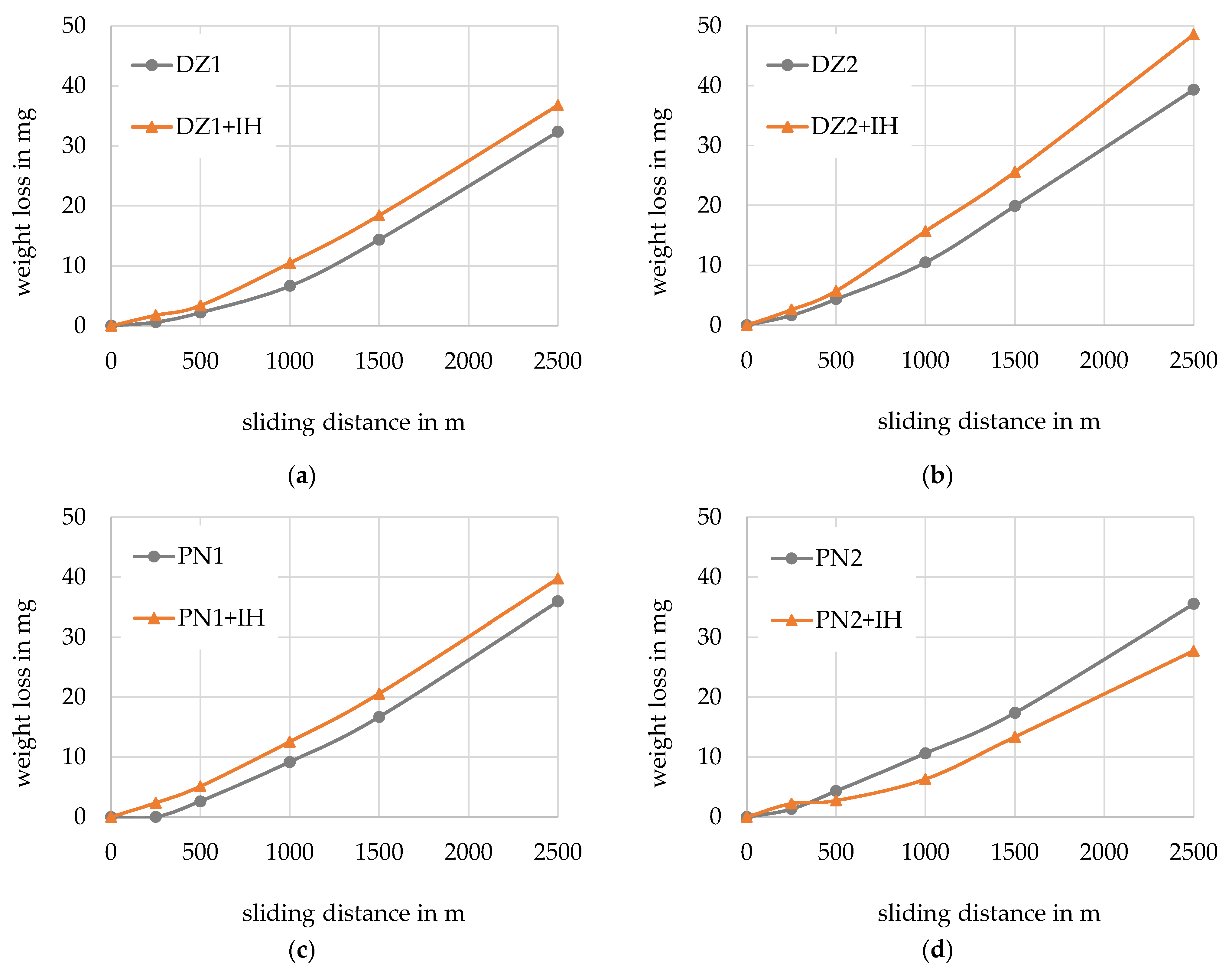
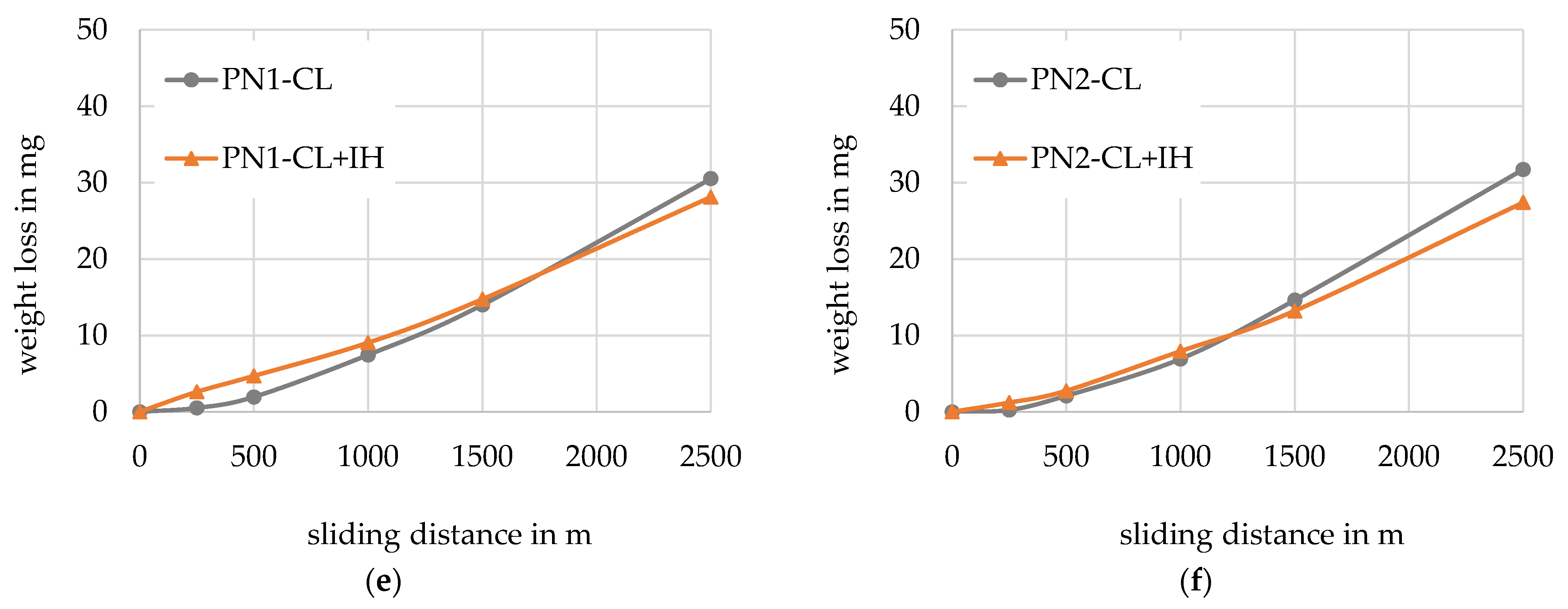

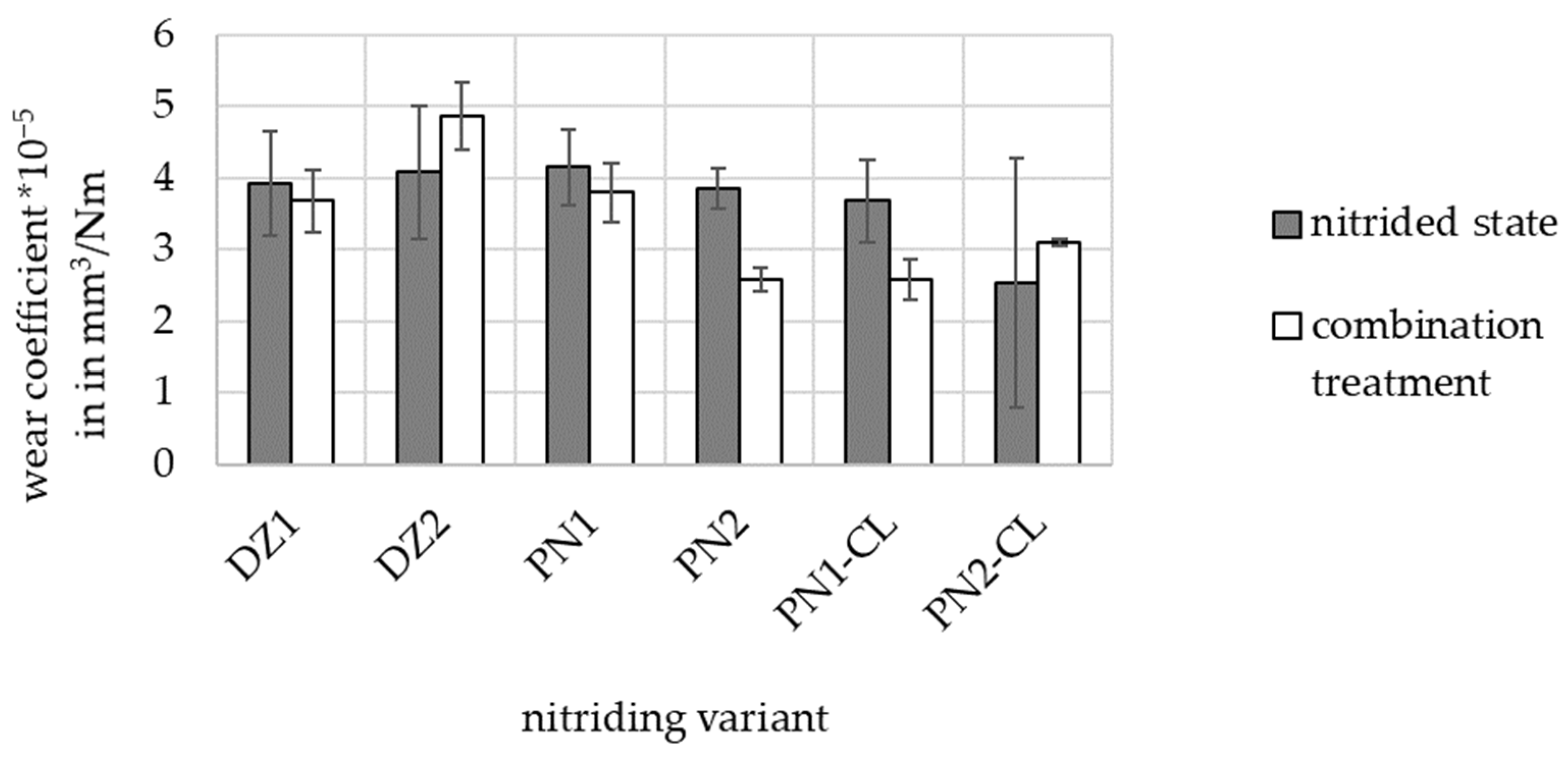

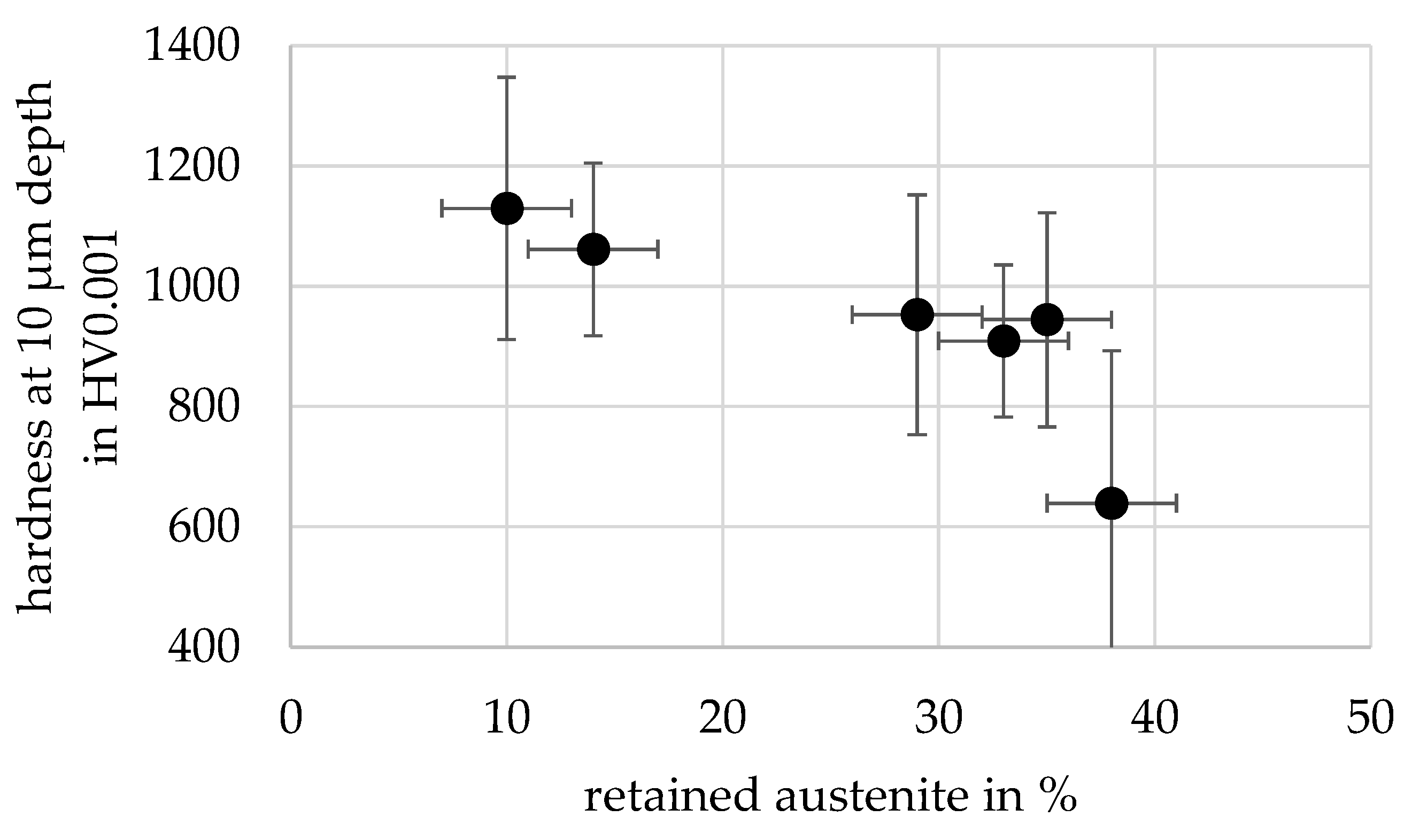
| Material | Fe | C | Si | Mn | Cr | Mo | V |
|---|---|---|---|---|---|---|---|
| EN31CrMoV9 | balance | 0.33 | 0.21 | 0.47 | 2.31 | 0.16 | 0.12 |
| ENX153CrMoV12 | balance | 1.51 | 0.33 | 0.37 | 11.59 | 0.92 | 0.80 |
| Variant | Temperature in °C | Time in h | Nitriding Potential KN |
|---|---|---|---|
| DZ1 | 500 | 8 | 0.7 |
| DZ2 | 520 | 20 | 0.5 |
| Variant | Temperature in °C | Time in h | N2:H2 |
|---|---|---|---|
| PN1 | 500 | 8 | 1:4 |
| PN2 | 520 | 20 | 1:5 |
| Variant | CLT in µm | NHD in mm |
|---|---|---|
| DZ1 | <1 µm | 0.18 |
| DZ2 | <1 µm | 0.33 |
| PN1 | 2.7 | 0.22 |
| PN2 | 2.9 | 0.27 |
| PN1-CL | - | 0.22 |
| PN2-CL | - | 0.27 |
| Variant | SHD in mm | Retained Austenite in ma. % |
|---|---|---|
| DZ1 | 1.02 | 38 |
| DZ2 | 1.05 | 29 |
| PN1 | 1.04 | 35 |
| PN2 | 1.02 | 33 |
| PN1-CL | 1.05 | 10 |
| PN2-CL | 1.03 | 14 |
| Variant | 250 m | 2500 m | ||
|---|---|---|---|---|
| N | N + IH | N | N + IH | |
| DZ1 | 0.62 | 1.76 | 32.32 | 36.74 |
| DZ2 | 1.65 | 2.59 | 39.30 | 48.51 |
| PN1 | 0.01 | 2.36 | 35.93 | 39.76 |
| PN2 | 1.33 | 2.25 | 35.52 | 27.74 |
| PN1-CL | 0.50 | 2.60 | 30.51 | 28.10 |
| PN2-CL | 0.24 | 1.19 | 31.70 | 27.39 |
Disclaimer/Publisher’s Note: The statements, opinions and data contained in all publications are solely those of the individual author(s) and contributor(s) and not of MDPI and/or the editor(s). MDPI and/or the editor(s) disclaim responsibility for any injury to people or property resulting from any ideas, methods, instructions or products referred to in the content. |
© 2023 by the authors. Licensee MDPI, Basel, Switzerland. This article is an open access article distributed under the terms and conditions of the Creative Commons Attribution (CC BY) license (https://creativecommons.org/licenses/by/4.0/).
Share and Cite
Hoja, S.; Birjandi, B.K.; Hasselbruch, H.; Epp, J. An Investigation into the Wear Behavior of Martensitically Transformed Nitrided Layers. Lubricants 2023, 11, 481. https://doi.org/10.3390/lubricants11110481
Hoja S, Birjandi BK, Hasselbruch H, Epp J. An Investigation into the Wear Behavior of Martensitically Transformed Nitrided Layers. Lubricants. 2023; 11(11):481. https://doi.org/10.3390/lubricants11110481
Chicago/Turabian StyleHoja, Stefanie, Behrad Komeili Birjandi, Henning Hasselbruch, and Jérémy Epp. 2023. "An Investigation into the Wear Behavior of Martensitically Transformed Nitrided Layers" Lubricants 11, no. 11: 481. https://doi.org/10.3390/lubricants11110481





